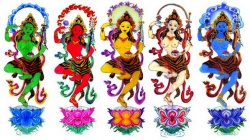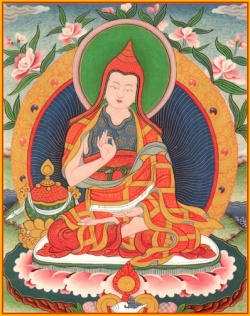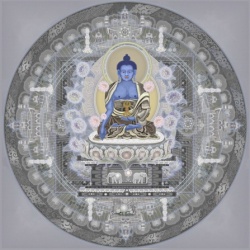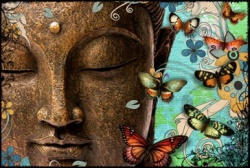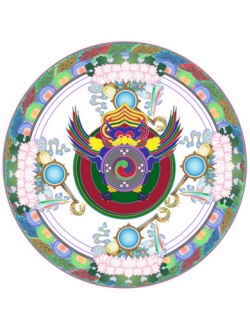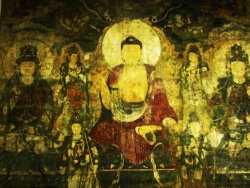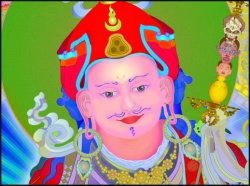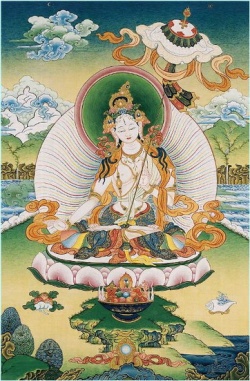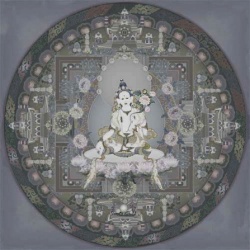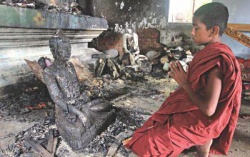Difference between revisions of "Bodhicharyavatara"
m (Text replacement - "{{Wiki|related}}" to "related") |
|||
| Line 8: | Line 8: | ||
[[Ringu Tulku Rinpoche]] said: | [[Ringu Tulku Rinpoche]] said: | ||
| − | :There are many different teachings on the [[Mahayana]] or [[bodhisattva]] [[path]]. What’s a [[bodhisattva]]? How to be a [[bodhisattva]]? All these different practices, [[meditations]], and [[philosophies]]. But in [[essence]], what is this [[path]] and how does one practice it? In the ''[[Bodhicharyavatara]]'', [[Shantideva]] gives the [[essential]] [[path]] of the [[bodhisattva]]. He does not comment in detail on one particular [[sutra]] or topic, but he essentializes the whole spectrum of the [[Mahayana teachings]], and puts them into a nutshell--so that we can see what it really means, in [[essence]]. | + | :There are many different teachings on the [[Mahayana]] or [[bodhisattva]] [[path]]. What’s a [[bodhisattva]]? How to be a [[bodhisattva]]? All these different practices, [[meditations]], and [[philosophies]]. But in [[essence]], what is this [[path]] and how does one [[practice]] it? In the ''[[Bodhicharyavatara]]'', [[Shantideva]] gives the [[essential]] [[path]] of the [[bodhisattva]]. He does not comment in detail on one particular [[sutra]] or topic, but he essentializes the whole spectrum of the [[Mahayana teachings]], and puts them into a nutshell--so that we can see what it really means, in [[essence]]. |
[[Tsoknyi Rinpoche]] said: | [[Tsoknyi Rinpoche]] said: | ||
| − | :The ''[[Bodhicharyavatara]]'' teaches the complete [[Mahayana]] [[path]] to [[enlightenment]], including all necessary preliminary, main, and concluding practices. A perfect [[path]] in itself, it is also at the same [[time]] a perfect support for all practitioners of the [[Vajrayana]] teachings in general. Practitioners learn how to develop the [[motivation]] of [[bodhichitta]], as well as how to carry out the application of the [[six paramitas]] or [[transcendental]] [[perfections]]. They learn how to fuse their practice of [[bodhichitta]] and the five first [[perfections]] with the sixth [[perfection]], [[wisdom]].<ref> ''[[Drops of Nectar]], [[Khenpo Kunpal's]] commentary on [[Shantideva's]] Entering the Conduct of the [[Bodhisattvas]]'', Volume 1, page 83, translated by Andreas Kretschmar. </ref> | + | :The ''[[Bodhicharyavatara]]'' teaches the complete [[Mahayana]] [[path]] to [[enlightenment]], including all necessary preliminary, main, and concluding practices. A {{Wiki|perfect}} [[path]] in itself, it is also at the same [[time]] a {{Wiki|perfect}} support for all practitioners of the [[Vajrayana]] teachings in general. Practitioners learn how to develop the [[motivation]] of [[bodhichitta]], as well as how to carry out the application of the [[six paramitas]] or [[transcendental]] [[perfections]]. They learn how to fuse their [[practice]] of [[bodhichitta]] and the five first [[perfections]] with the sixth [[perfection]], [[wisdom]].<ref> ''[[Drops of Nectar]], [[Khenpo Kunpal's]] commentary on [[Shantideva's]] Entering the Conduct of the [[Bodhisattvas]]'', Volume 1, page 83, translated by Andreas Kretschmar. </ref> |
[[Khenpo Namdrol]] said: | [[Khenpo Namdrol]] said: | ||
| − | :Concerning the study of the ''[[Bodhicharyavatara]]'', my [[teacher]] [[Khenpo Tsöndrü]] told me that though the meaning of the text is not difficult to understand, applying the teachings to one’s [[mind]] is far more difficult. The purpose of the [[dharma]] is to [[transform]] the [[mind]], to free us from our [[attachment]] to [[worldly]] concerns. Among all treatises and texts, [[Shantideva’s]] ''[[Bodhicharyavatara]]'' and Paltrul [[Rinpoche’s]] ''[[Words of My Perfect Teacher]]'' are the most powerful texts that serve this purpose. If a qualified [[teacher]] carefully explains these two texts, a diligent student can definitely [[transform]] his or her [[mind]] and become free from [[worldly]] concerns… | + | :Concerning the study of the ''[[Bodhicharyavatara]]'', my [[teacher]] [[Khenpo Tsöndrü]] told me that though the meaning of the text is not difficult to understand, applying the teachings to one’s [[mind]] is far more difficult. The {{Wiki|purpose}} of the [[dharma]] is to [[transform]] the [[mind]], to free us from our [[attachment]] to [[worldly]] concerns. Among all treatises and texts, [[Shantideva’s]] ''[[Bodhicharyavatara]]'' and Paltrul [[Rinpoche’s]] ''[[Words of My Perfect Teacher]]'' are the most powerful texts that serve this {{Wiki|purpose}}. If a qualified [[teacher]] carefully explains these two texts, a diligent [[student]] can definitely [[transform]] his or her [[mind]] and become free from [[worldly]] concerns… |
| − | :While the ''[[Bodhicharyavatara]]'' is designed to [[transform]] a practitioner’s [[mind]] from the very outset, the other major [[Indian]] texts do not have this immediate practical applicability. The ''[[Abhisamayalankara]]'' for instance teaches extensively on the ten [[bodhisattva levels]] and [[five paths]]. How can [[people]] who have not even reached the first [[bodhisattva]] level apply these teachings to their [[minds]]? Even a complete beginner, on the other hand, can immediately make use of the teachings of the ''[[Bodhicharyavatara]]''. The ''[[Bodhicharyavatara]]'' shows the methods, contemplations and [[meditations]] for [[transforming]] our [[minds]], tells us how to free ourselves from [[worldly]] concerns, and thus how to become genuine practitioners. [[Khenpo Tsöndrü]] said that for these [[reasons]] the ''[[Bodhicharyavatara]]'' must be taught and studied extensively. | + | :While the ''[[Bodhicharyavatara]]'' is designed to [[transform]] a practitioner’s [[mind]] from the very outset, the other major [[Indian]] texts do not have this immediate {{Wiki|practical}} applicability. The ''[[Abhisamayalankara]]'' for instance teaches extensively on the ten [[bodhisattva levels]] and [[five paths]]. How can [[people]] who have not even reached the first [[bodhisattva]] level apply these teachings to their [[minds]]? Even a complete beginner, on the other hand, can immediately make use of the teachings of the ''[[Bodhicharyavatara]]''. The ''[[Bodhicharyavatara]]'' shows the methods, contemplations and [[meditations]] for [[transforming]] our [[minds]], tells us how to free ourselves from [[worldly]] concerns, and thus how to become genuine practitioners. [[Khenpo Tsöndrü]] said that for these [[reasons]] the ''[[Bodhicharyavatara]]'' must be [[taught]] and studied extensively. |
| − | :I myself can only agree with my [[teacher]] [[Khenpo Tsöndrü]]. I truly believe that among all the [[Indian]] treatises, the ''[[Bodhicharyavatara]]'' is the most beneficial to any sincere [[practitioner]]. The [[Buddhist teachings]] are vast and profound. There are countless [[sutras]], treatises, [[tantras]] and instruction manuals. For a beginner, who really aspires to become a genuine [[dharma]] [[practitioner]], in my opinion no [[book]] is more suitable than the ''[[Bodhicharyavatara]]''. This text is a perfect gateway to the [[dharma]]. This text is a perfect guide and companion throughout a practitioner’s entire [[life]]. The way [[Shantideva]] presents the [[dharma]] directly strikes one’s [[heart]]. This is his special feature. He talks straight to your [[heart]]. The teachings of the ''[[Bodhicharyavatara]]'' are {{Wiki|common sense}}. Whoever receives or reads these teachings will agree and will think, “This is really true.” Since this [[manner]] of presenting the [[dharma]] is so clear and easy to understand, it transforms one’s [[mind]] if applied in daily [[life]]. <ref> ''[[Drops of Nectar]], [[Khenpo Kunpal's]] commentary on [[Shantideva's]] Entering the Conduct of the [[Bodhisattvas]]'', Volume 1, page 133, translated by Andreas Kretschmar. </ref> | + | :I myself can only agree with my [[teacher]] [[Khenpo Tsöndrü]]. I truly believe that among all the [[Indian]] treatises, the ''[[Bodhicharyavatara]]'' is the most beneficial to any {{Wiki|sincere}} [[practitioner]]. The [[Buddhist teachings]] are vast and profound. There are countless [[sutras]], treatises, [[tantras]] and instruction manuals. For a beginner, who really aspires to become a genuine [[dharma]] [[practitioner]], in my opinion no [[book]] is more suitable than the ''[[Bodhicharyavatara]]''. This text is a {{Wiki|perfect}} gateway to the [[dharma]]. This text is a {{Wiki|perfect}} guide and companion throughout a practitioner’s entire [[life]]. The way [[Shantideva]] presents the [[dharma]] directly strikes one’s [[heart]]. This is his special feature. He talks straight to your [[heart]]. The teachings of the ''[[Bodhicharyavatara]]'' are {{Wiki|common sense}}. Whoever receives or reads these teachings will agree and will think, “This is really true.” Since this [[manner]] of presenting the [[dharma]] is so clear and easy to understand, it transforms one’s [[mind]] if applied in daily [[life]]. <ref> ''[[Drops of Nectar]], [[Khenpo Kunpal's]] commentary on [[Shantideva's]] Entering the Conduct of the [[Bodhisattvas]]'', Volume 1, page 133, translated by Andreas Kretschmar. </ref> |
==Studying and Practising this Text== | ==Studying and Practising this Text== | ||
[[His Holiness the Dalai Lama]] advises: | [[His Holiness the Dalai Lama]] advises: | ||
| − | :[[Shantideva]] composed his text in the [[form]] of an inner dialog. He turned his own [[weapons]] upon himself, doing battle with his [[negative emotions]]. Therefore, when we teach or listen to this text, it is important that we do so in order to progress [[spiritually]], rather than making it simply a [[subject]] of {{Wiki|academic}} study.<ref> ''A Flash of Lightening in the Dark of Night: [[A Guide to the Bodhisattva's Way of Life]]'', by the [[Dalai Lama]], page 1. </ref> | + | :[[Shantideva]] composed his text in the [[form]] of an inner dialog. He turned his [[own]] [[weapons]] upon himself, doing {{Wiki|battle}} with his [[negative emotions]]. Therefore, when we teach or listen to this text, it is important that we do so in order to progress [[spiritually]], rather than making it simply a [[subject]] of {{Wiki|academic}} study.<ref> ''A Flash of Lightening in the Dark of Night: [[A Guide to the Bodhisattva's Way of Life]]'', by the [[Dalai Lama]], page 1. </ref> |
For {{Wiki|Western}} students who are non-Buddhists, or who may be new to [[Buddhism]], but who do not yet have a [[teacher]] and may not have a clear [[understanding]] of [[Buddhist]] [[Wikipedia:concept|concepts]] such as [[karma]] and [[interdependence]], a commentary such as [[Pema Chodron's]] ''No [[Time]] to Lose'' may be the most suitable introduction to this text. This commentary is intended for a general audience and it explains basic [[Buddhist]] [[Wikipedia:concept|concepts]] in simple terms that can be easily understood. | For {{Wiki|Western}} students who are non-Buddhists, or who may be new to [[Buddhism]], but who do not yet have a [[teacher]] and may not have a clear [[understanding]] of [[Buddhist]] [[Wikipedia:concept|concepts]] such as [[karma]] and [[interdependence]], a commentary such as [[Pema Chodron's]] ''No [[Time]] to Lose'' may be the most suitable introduction to this text. This commentary is intended for a general audience and it explains basic [[Buddhist]] [[Wikipedia:concept|concepts]] in simple terms that can be easily understood. | ||
| Line 32: | Line 32: | ||
:The ''[[Bodhicharyavatara]]'' is the most practice-oriented of all the [[Indian]] [[Buddhist]] treatises and texts. It contains all the necessary key points a [[practitioner]] needs to know and is relatively easy to study and understand. The ''[[Bodhicharyavatara]]'' is a text to be practiced and not simply studied. Genuine [[understanding]] comes about only through practicing the teachings. As [[Atisha]] said, “Intense study brings only some [[understanding]]. Practice, however, brings great [[understanding]].” | :The ''[[Bodhicharyavatara]]'' is the most practice-oriented of all the [[Indian]] [[Buddhist]] treatises and texts. It contains all the necessary key points a [[practitioner]] needs to know and is relatively easy to study and understand. The ''[[Bodhicharyavatara]]'' is a text to be practiced and not simply studied. Genuine [[understanding]] comes about only through practicing the teachings. As [[Atisha]] said, “Intense study brings only some [[understanding]]. Practice, however, brings great [[understanding]].” | ||
| − | :The ''[[Bodhicharyavatara]]'' can be practiced according to the ‘sequence of [[meditation]]’ as taught in the manuals written by [[Rongtönpa]] ([[The Garland of Jewel Ornaments]]) and [[Patrul Rinpoche]] ([[The Brightly Shining Sun]]). Following these manuals, the ''[[Bodhicharyavatara]]'' is practiced in a particular order and is used as a text for ‘[[mind-training]]’. | + | :The ''[[Bodhicharyavatara]]'' can be practiced according to the ‘sequence of [[meditation]]’ as [[taught]] in the manuals written by [[Rongtönpa]] ([[The Garland of Jewel Ornaments]]) and [[Patrul Rinpoche]] ([[The Brightly Shining Sun]]). Following these manuals, the ''[[Bodhicharyavatara]]'' is practiced in a particular order and is used as a text for ‘[[mind-training]]’. |
| − | :From the viewpoint of a beginner the best way to access the ''[[Bodhicharyavatara]]'' is as follows: Choose one [[stanza]] of the text and make the commitment to practice it.<ref>Note that [[Khenpo Appey]] is referring to beginning students who are already [[Buddhists]] and who have a clear [[understanding]] of basic [[Wikipedia:concept|concepts]] such as [[karma]] and [[interdependence]]. Some [[dharma]] [[teachers]] in the [[West]] have expressed the [[concern]] that if {{Wiki|Western}} students begin studying the [[root text]] without the proper [[understanding]] of basic [[Buddhist]] [[Wikipedia:concept|concepts]], this can lead to {{Wiki|confusion}}.</ref> At first think about the meaning of this particular [[teaching]] and then try to apply it in your daily [[activities]]. At the very moment when [[afflictions]] such as [[ignorance]], [[anger]], [[desire]], [[jealousy]] or [[miserliness]] arise, apply the [[stanza]] you are practicing to the situation. By gradually incorporating more [[stanzas]] into your daily practice, you will eventually know the entire text by [[heart]] and will be able to apply each respective [[stanza]] to the appropriate situation. That is the [[benefit]] that accrues from memorizing the text. | + | :From the viewpoint of a beginner the best way to access the ''[[Bodhicharyavatara]]'' is as follows: Choose one [[stanza]] of the text and make the commitment to [[practice]] it.<ref>Note that [[Khenpo Appey]] is referring to beginning students who are already [[Buddhists]] and who have a clear [[understanding]] of basic [[Wikipedia:concept|concepts]] such as [[karma]] and [[interdependence]]. Some [[dharma]] [[teachers]] in the [[West]] have expressed the [[concern]] that if {{Wiki|Western}} students begin studying the [[root text]] without the proper [[understanding]] of basic [[Buddhist]] [[Wikipedia:concept|concepts]], this can lead to {{Wiki|confusion}}.</ref> At first think about the meaning of this particular [[teaching]] and then try to apply it in your daily [[activities]]. At the very [[moment]] when [[afflictions]] such as [[ignorance]], [[anger]], [[desire]], [[jealousy]] or [[miserliness]] arise, apply the [[stanza]] you are practicing to the situation. By gradually incorporating more [[stanzas]] into your daily [[practice]], you will eventually know the entire text by [[heart]] and will be able to apply each respective [[stanza]] to the appropriate situation. That is the [[benefit]] that accrues from memorizing the text. |
:Merely recalling the appropriate [[stanza]] in situations when your [[mind]] is ablaze with [[afflictions]] will allow the power of the words of the ''[[Bodhicharyavatara]]'' to pacify the situation. [[Understanding]] the text’s meaning increases its capacity to tame [[afflictions]]. The full power of each [[stanza]] does not [[manifest]] through simply remembering it one [[time]] in a difficult situation. These teachings must be practiced again and again, and constantly applied to one’s daily [[life]]. This approach to taming the [[mind]] is called ‘[[mind-training]]’. | :Merely recalling the appropriate [[stanza]] in situations when your [[mind]] is ablaze with [[afflictions]] will allow the power of the words of the ''[[Bodhicharyavatara]]'' to pacify the situation. [[Understanding]] the text’s meaning increases its capacity to tame [[afflictions]]. The full power of each [[stanza]] does not [[manifest]] through simply remembering it one [[time]] in a difficult situation. These teachings must be practiced again and again, and constantly applied to one’s daily [[life]]. This approach to taming the [[mind]] is called ‘[[mind-training]]’. | ||
| − | :The only way to truly overcome all [[afflictions]] is through practicing the [[view]] of [[emptiness]]. Practicing the [[skillful means]] of [[compassion]], [[patience]] and so forth overcomes [[afflictions]] to some extent, but not completely. Practitioners should undertake [[mind-training]] embraced with the [[view]] of [[emptiness]] as taught in the [[traditions]] of [[Madyamaka]], [[Mahamudra]] or [[Mahasandhi]]. Practice the [[view]] of [[emptiness]] according to the oral instructions of your [[root guru]] and let your [[bodhichitta]] [[motivation]] and [[bodhisattva]] conduct be guided by the ''[[Bodhicharyavatara]]''. According to [[Mipham Rinpoche]], the [[view]] of [[Prasangika Madyamaka]] as taught in the ninth chapter of the ''[[Bodhicharyavatara]]'' and the [[view]] of the [[Great Perfection]] are [[identical]]. Another crucial text for any [[practitioner]] who wants to develop certainty in the [[view]] is [[Madhyamakavatara]]. For the best results, practitioners should combine the study and practice of these texts with the direct instructions of their [[masters]].<ref> ''[[Drops of Nectar]], [[Khenpo Kunpal's]] commentary on [[Shantideva's]] Entering the Conduct of the [[Bodhisattvas]]'', Volume 1, page 115, translated by Andreas Kretschmar. </ref> | + | :The only way to truly overcome all [[afflictions]] is through practicing the [[view]] of [[emptiness]]. Practicing the [[skillful means]] of [[compassion]], [[patience]] and so forth overcomes [[afflictions]] to some extent, but not completely. Practitioners should undertake [[mind-training]] embraced with the [[view]] of [[emptiness]] as [[taught]] in the [[traditions]] of [[Madyamaka]], [[Mahamudra]] or [[Mahasandhi]]. Practice the [[view]] of [[emptiness]] according to the oral instructions of your [[root guru]] and let your [[bodhichitta]] [[motivation]] and [[bodhisattva]] conduct be guided by the ''[[Bodhicharyavatara]]''. According to [[Mipham Rinpoche]], the [[view]] of [[Prasangika Madyamaka]] as [[taught]] in the ninth [[chapter]] of the ''[[Bodhicharyavatara]]'' and the [[view]] of the [[Great Perfection]] are [[identical]]. Another crucial text for any [[practitioner]] who wants to develop {{Wiki|certainty}} in the [[view]] is [[Madhyamakavatara]]. For the best results, practitioners should combine the study and [[practice]] of these texts with the direct instructions of their [[masters]].<ref> ''[[Drops of Nectar]], [[Khenpo Kunpal's]] commentary on [[Shantideva's]] Entering the Conduct of the [[Bodhisattvas]]'', Volume 1, page 115, translated by Andreas Kretschmar. </ref> |
[[Dilgo Khyentse Rinpoche]] said: | [[Dilgo Khyentse Rinpoche]] said: | ||
| − | :Immerse yourself in the meaning of the teachings, day after day, month after month, and the [[spiritual]] qualities of a [[bodhisattva]] will develop without difficulty, like [[honey]] collecting in the hive as the bees go from [[flower]] to [[flower]], [[gathering]] [[nectar]].<ref> ''The {{Wiki|Excellent}} [[Path]] to [[Enlightenment]]'', by [[Dilgo Khyentse Rinpoche]], Snow Lion Publications, page 10. </ref> | + | :Immerse yourself in the meaning of the teachings, day after day, month after month, and the [[spiritual]] qualities of a [[bodhisattva]] will develop without difficulty, like [[honey]] collecting in the hive as the bees go from [[flower]] to [[flower]], [[gathering]] [[nectar]].<ref> ''The {{Wiki|Excellent}} [[Path]] to [[Enlightenment]]'', by [[Dilgo Khyentse Rinpoche]], [[Snow Lion Publications]], page 10. </ref> |
==Styles of [[Teaching]]== | ==Styles of [[Teaching]]== | ||
| − | According to [[Alak Zenkar Rinpoche]], [[Patrul Rinpoche]] started the [[tradition]] of [[teaching]] the ''[[Bodhicharyavatara]]'' continuously. This meant that if at least three or four texts were being taught in a [[monastery]], one of them had to be the ''[[Bodhicharyavatara]]''. When finishing the tenth chapter, the [[teacher]] would not stop there, but would go back to the beginning of the text and teach a little of that before ending the session. | + | According to [[Alak Zenkar Rinpoche]], [[Patrul Rinpoche]] started the [[tradition]] of [[teaching]] the ''[[Bodhicharyavatara]]'' continuously. This meant that if at least three or four texts were being [[taught]] in a [[monastery]], one of them had to be the ''[[Bodhicharyavatara]]''. When finishing the tenth [[chapter]], the [[teacher]] would not stop there, but would go back to the beginning of the text and teach a little of that before ending the session. |
[[Khenpo Appey]] said: | [[Khenpo Appey]] said: | ||
| − | :In general in [[Tibet]], [[Buddhist]] treatises and texts were taught only to [[monks]]. This was because [[Buddhist]] [[knowledge]] was handed down exclusively in [[monastic]] communities. Texts like the ''[[Bodhicharyavatara]]'' were taught in a [[shedra]], a place for the study of [[Buddhist philosophy]]… | + | :In general in [[Tibet]], [[Buddhist]] treatises and texts were [[taught]] only to [[monks]]. This was because [[Buddhist]] [[knowledge]] was handed down exclusively in [[monastic]] communities. Texts like the ''[[Bodhicharyavatara]]'' were [[taught]] in a [[shedra]], a place for the study of [[Buddhist philosophy]]… |
| − | :[[Paltrul Rinpoche]] broke with the [[tradition]] of [[teaching]] [[Buddhist]] treatises exclusively to [[monastic]] communities. He was the first [[Buddhist master]] in [[Tibet]] who began [[teaching]] the ''[[Bodhicharyavatara]]'' to huge crowds of [[lay people]]. While the audience may not have understood the {{Wiki|subtle}} meaning of the entire text, [[Paltrul Rinpoche]] taught so as to make the major points easy to understand. | + | :[[Paltrul Rinpoche]] broke with the [[tradition]] of [[teaching]] [[Buddhist]] treatises exclusively to [[monastic]] communities. He was the first [[Buddhist master]] in [[Tibet]] who began [[teaching]] the ''[[Bodhicharyavatara]]'' to huge crowds of [[lay people]]. While the audience may not have understood the {{Wiki|subtle}} meaning of the entire text, [[Paltrul Rinpoche]] [[taught]] so as to make the major points easy to understand. |
:When [[teaching]] a non-scholastic audience, one must condense the meaning and {{Wiki|present}} it repeatedly in simple [[language]], illustrating points through everyday examples and stories. In old [[Tibet]] many faithful and devoted [[lay people]] were kept from studying the genuine [[dharma]] since few [[teachers]] made the [[effort]] to explain the [[dharma]] in easy terms to non-scholars.<ref> ''[[Drops of Nectar]], [[Khenpo Kunpal's]] commentary on [[Shantideva's]] Entering the Conduct of the [[Bodhisattvas]]'', Volume 1, page 117, translated by Andreas Kretschmar. </ref> | :When [[teaching]] a non-scholastic audience, one must condense the meaning and {{Wiki|present}} it repeatedly in simple [[language]], illustrating points through everyday examples and stories. In old [[Tibet]] many faithful and devoted [[lay people]] were kept from studying the genuine [[dharma]] since few [[teachers]] made the [[effort]] to explain the [[dharma]] in easy terms to non-scholars.<ref> ''[[Drops of Nectar]], [[Khenpo Kunpal's]] commentary on [[Shantideva's]] Entering the Conduct of the [[Bodhisattvas]]'', Volume 1, page 117, translated by Andreas Kretschmar. </ref> | ||
[[Khenpo]] Trashi [[Palden]] said: | [[Khenpo]] Trashi [[Palden]] said: | ||
| − | :In general, there are two styles of [[teaching]] the ''[[Bodhicharyavatara]]'': ‘the {{Wiki|scholastic}} explanation style’ and ‘the practice instruction style’. [[Patrul Rinpoche’s]] teachings on the ''[[Bodhicharyavatara]]'' as recorded by [[Thubten Chökyi Drakpa]] follow ‘the {{Wiki|scholastic}} explanation style’, while [[Khenpo Kunpal]]’s commentary [[Drops of Nectar]] preserves [[Patrul Rinpoche’s]] teachings in ‘the practice instruction style’. [[Khenpo]] Kunpal’s commentary on the ninth chapter of the ''[[Bodhicharyavatara]]'' is based on [[Mipham Rinpoche’s]] [[The Ketaka Gem|Norbu Ketaka]], which he wrote according to the teachings of [[Patrul Rinpoche]]. The study and practice of the ''[[Bodhicharyavatara]]'' became so popular in all [[shedras]] of [[East Tibet]] due to [[Paltrul Rinpoche’s]] influence. This text can truly [[transform]] the [[mind]] of a sincere [[practitioner]]. | + | :In general, there are two styles of [[teaching]] the ''[[Bodhicharyavatara]]'': ‘the {{Wiki|scholastic}} explanation style’ and ‘the [[practice]] instruction style’. [[Patrul Rinpoche’s]] teachings on the ''[[Bodhicharyavatara]]'' as recorded by [[Thubten Chökyi Drakpa]] follow ‘the {{Wiki|scholastic}} explanation style’, while [[Khenpo Kunpal]]’s commentary [[Drops of Nectar]] preserves [[Patrul Rinpoche’s]] teachings in ‘the [[practice]] instruction style’. [[Khenpo]] Kunpal’s commentary on the ninth [[chapter]] of the ''[[Bodhicharyavatara]]'' is based on [[Mipham Rinpoche’s]] [[The Ketaka Gem|Norbu Ketaka]], which he wrote according to the teachings of [[Patrul Rinpoche]]. The study and [[practice]] of the ''[[Bodhicharyavatara]]'' became so popular in all [[shedras]] of [[East Tibet]] due to [[Paltrul Rinpoche’s]] influence. This text can truly [[transform]] the [[mind]] of a {{Wiki|sincere}} [[practitioner]]. |
:In our [[shedra]], students would study [[Khenpo Kunpal’s]] commentary on the ''[[Bodhicharyavatara]]'' at the beginning of their first year… [[Annotated Commentary on the Bodhicharyavatara| Khenpo Zhenga’s annotation commentary]] would be studied later, according to the [[teaching]] sequence of ‘the thirteen great textbooks of [[Indian]] origin’. | :In our [[shedra]], students would study [[Khenpo Kunpal’s]] commentary on the ''[[Bodhicharyavatara]]'' at the beginning of their first year… [[Annotated Commentary on the Bodhicharyavatara| Khenpo Zhenga’s annotation commentary]] would be studied later, according to the [[teaching]] sequence of ‘the thirteen great textbooks of [[Indian]] origin’. | ||
| − | :…In our [[shedra]] only these two commentaries on the ''[[Bodhicharyavatara]]'' were taught, but the [[khenpo]] and the assistant [[teachers]] sometimes quoted from other commentaries during the [[teaching]] sessions. In our homework sessions, we students could compare different commentaries from other schools to gain a more profound [[understanding]] of the text. <ref> ''[[Drops of Nectar]], [[Khenpo Kunpal's]] commentary on [[Shantideva's]] Entering the Conduct of the [[Bodhisattvas]]'', Volume 1, page 127, translated by Andreas Kretschmar. </ref> | + | :…In our [[shedra]] only these two commentaries on the ''[[Bodhicharyavatara]]'' were [[taught]], but the [[khenpo]] and the assistant [[teachers]] sometimes quoted from other commentaries during the [[teaching]] sessions. In our homework sessions, we students could compare different commentaries from other schools to gain a more profound [[understanding]] of the text. <ref> ''[[Drops of Nectar]], [[Khenpo Kunpal's]] commentary on [[Shantideva's]] Entering the Conduct of the [[Bodhisattvas]]'', Volume 1, page 127, translated by Andreas Kretschmar. </ref> |
==The Structure of the Text== | ==The Structure of the Text== | ||
| Line 86: | Line 86: | ||
*The next three chapters (4, 5 and 6) explain how to prevent [[bodhichitta]] from {{Wiki|decreasing}} or being dissipated. | *The next three chapters (4, 5 and 6) explain how to prevent [[bodhichitta]] from {{Wiki|decreasing}} or being dissipated. | ||
*The next three chapters (7, 8 and 9) explain how to make the [[bodhichitta]] increase further and further. | *The next three chapters (7, 8 and 9) explain how to make the [[bodhichitta]] increase further and further. | ||
| − | *The 10th chapter is a concluding [[prayer]] of [[dedication]]. | + | *The 10th [[chapter]] is a concluding [[prayer]] of [[dedication]]. |
| − | ===Outline by Chapter=== | + | ===Outline by [[Chapter]]=== |
The text of the [[Bodhicharyavatara]] has ten chapters. Most commentaries also include an introduction that establishes the context and background for the text. | The text of the [[Bodhicharyavatara]] has ten chapters. Most commentaries also include an introduction that establishes the context and background for the text. | ||
| − | The chapter titles are listed below; the outlines for each chapter are based on the commentary by [[Khenpo Kunpal]], called [[Drops of Nectar]]. These outlines will be posted as they become available. | + | The [[chapter]] titles are listed below; the outlines for each [[chapter]] are based on the commentary by [[Khenpo Kunpal]], called [[Drops of Nectar]]. These outlines will be posted as they become available. |
*Introduction | *Introduction | ||
| − | *Chapter 1: The [[Excellence]] of [[Bodhichitta]] | + | *[[Chapter]] 1: The [[Excellence]] of [[Bodhichitta]] |
| − | *Chapter 2: [[Confession]] | + | *[[Chapter]] 2: [[Confession]] |
| − | *Chapter 3: Taking Hold of [[Bodhichitta]] | + | *[[Chapter]] 3: Taking Hold of [[Bodhichitta]] |
| − | *Chapter 4: [[Carefulness]] | + | *[[Chapter]] 4: [[Carefulness]] |
| − | *Chapter 5: [[Vigilance]] - [[Bodhicharyavatara Chapter 5 Outline|Outline]] | + | *[[Chapter]] 5: [[Vigilance]] - [[Bodhicharyavatara Chapter 5 Outline|Outline]] |
| − | *Chapter 6: [[Patience]] - [[Bodhicharyavatara Chapter 6 Outline|Outline]] | + | *[[Chapter]] 6: [[Patience]] - [[Bodhicharyavatara Chapter 6 Outline|Outline]] |
| − | *Chapter 7: [[Diligence]] - [[Bodhicharyavatara Chapter 7 Outline|Outline]] | + | *[[Chapter]] 7: [[Diligence]] - [[Bodhicharyavatara Chapter 7 Outline|Outline]] |
| − | *Chapter 8: [[Meditation]] - [[Bodhicharyavatara Chapter 8 Outline|Outline]] | + | *[[Chapter]] 8: [[Meditation]] - [[Bodhicharyavatara Chapter 8 Outline|Outline]] |
| − | *Chapter 9: [[Wisdom]] | + | *[[Chapter]] 9: [[Wisdom]] |
| − | *Chapter 10: [[Dedication]] | + | *[[Chapter]] 10: [[Dedication]] |
==The [[Tibetan]] Translation== | ==The [[Tibetan]] Translation== | ||
| Line 131: | Line 131: | ||
:*[[Drukpa Pema Karpo]] (1527-1592) | :*[[Drukpa Pema Karpo]] (1527-1592) | ||
:*[[Mipham Rinpoche]] (1846-1912) | :*[[Mipham Rinpoche]] (1846-1912) | ||
| − | :::[[The Ketaka Gem]] (commentary on Chapter 9) | + | :::[[The Ketaka Gem]] (commentary on [[Chapter]] 9) |
:*[[Khenpo Shenga]] (1871-1927) | :*[[Khenpo Shenga]] (1871-1927) | ||
:::[[An Annotated Commentary on the 'Bodhicharyavatara']] | :::[[An Annotated Commentary on the 'Bodhicharyavatara']] | ||
:*[[Thubten Chökyi Drakpa]] (1823-1905) | :*[[Thubten Chökyi Drakpa]] (1823-1905) | ||
:::[[The Excellent Vase that Grants the Qualities of the Bodhisattvas]] (commentary on Chapters 1-8) | :::[[The Excellent Vase that Grants the Qualities of the Bodhisattvas]] (commentary on Chapters 1-8) | ||
| − | :::[[The Brilliant Torch]] (commentary on Chapter 9) | + | :::[[The Brilliant Torch]] (commentary on [[Chapter]] 9) |
:*[[Khenpo Kunpal]] (1862-1943) | :*[[Khenpo Kunpal]] (1862-1943) | ||
:::[[Drops of Nectar]] | :::[[Drops of Nectar]] | ||
| Line 148: | Line 148: | ||
====English==== | ====English==== | ||
| − | *[[Śāntideva]], ''The [[Bodhicaryāvatāra]]'', translated by Kate Crosby and Andrew Skilton, {{Wiki|Oxford University Press}}, 1995 | + | *[[Śāntideva]], ''The [[Bodhicaryāvatāra]]'', translated by Kate Crosby and [[Andrew Skilton]], {{Wiki|Oxford University Press}}, 1995 |
*''The Way of the [[Bodhisattva]]: A Translation of the [[Bodhicharyavatara]]'', translated by the [[Padmakara Translation Group]], [[Shambhala Publications]], 2003, ISBN 1590300572<br> | *''The Way of the [[Bodhisattva]]: A Translation of the [[Bodhicharyavatara]]'', translated by the [[Padmakara Translation Group]], [[Shambhala Publications]], 2003, ISBN 1590300572<br> | ||
| − | *''[[A Guide to the Bodhisattva Way]] of [[Life]]'', translated by Vesna and {{Wiki|Alan Wallace}}, Snow Lion Publications, 1997, ISBN 1559390611<br> | + | *''[[A Guide to the Bodhisattva Way]] of [[Life]]'', translated by Vesna and {{Wiki|Alan Wallace}}, [[Snow Lion Publications]], 1997, ISBN 1559390611<br> |
| − | *''A Guide to the [[Bodhisattva’s]] Way of [[Life]]'', translated by Stephen Batchelor, LTWA, ISBN 8185102597<br> | + | *''A Guide to the [[Bodhisattva’s]] Way of [[Life]]'', translated by [[Stephen Batchelor]], LTWA, ISBN 8185102597<br> |
===={{Wiki|French}}==== | ===={{Wiki|French}}==== | ||
| Line 175: | Line 175: | ||
*''[[Wisdom]]: Two [[Buddhist]] Commentaries'', [[Khenchen Kunzang Palden]] and [[Minyak Kunzang Sönam]], translated by [[Padmakara Translation Group]], 1993, 2nd edition 1999 | *''[[Wisdom]]: Two [[Buddhist]] Commentaries'', [[Khenchen Kunzang Palden]] and [[Minyak Kunzang Sönam]], translated by [[Padmakara Translation Group]], 1993, 2nd edition 1999 | ||
| − | *''The Center of the Sunlit Sky'' by Karl Brunnhölzl. Includes a translation of [[Pawo]] Tsuglak Trengwa’s Commentary on the Ninth Chapter, [[Wisdom]], of the [[Bodhicaryavatara]]. Published by [[Snow Lion]]. ISBN 1-55939-218-5 | + | *''The Center of the Sunlit Sky'' by Karl Brunnhölzl. Includes a translation of [[Pawo]] Tsuglak Trengwa’s Commentary on the Ninth [[Chapter]], [[Wisdom]], of the [[Bodhicaryavatara]]. Published by [[Snow Lion]]. ISBN 1-55939-218-5 |
==Contemporary Commentaries== | ==Contemporary Commentaries== | ||
*The [[Dalai Lama]], ''[[A Flash of Lightning in the Dark of Night]]: A Guide to the [[Bodhisattva’s]] Way of [[Life]]'', [[Shambhala]], 1994, ISBN 0877739714 | *The [[Dalai Lama]], ''[[A Flash of Lightning in the Dark of Night]]: A Guide to the [[Bodhisattva’s]] Way of [[Life]]'', [[Shambhala]], 1994, ISBN 0877739714 | ||
| − | *The [[Dalai Lama]], ''[[Healing]] [[Anger]], The Power of [[Patience]] from a [[Buddhist]] {{Wiki|Perspective}}'', [[Snow Lion]], 1997 (A commentary on chapter 6) | + | *The [[Dalai Lama]], ''[[Healing]] [[Anger]], The Power of [[Patience]] from a [[Buddhist]] {{Wiki|Perspective}}'', [[Snow Lion]], 1997 (A commentary on [[chapter]] 6) |
| − | *The [[Dalai Lama]], ''Practicing [[Wisdom]]'', [[Wisdom]], 2004 (A commentary on chapter 9) | + | *The [[Dalai Lama]], ''Practicing [[Wisdom]]'', [[Wisdom]], 2004 (A commentary on [[chapter]] 9) |
| − | *HH the [[Dalai Lama]], ''[[Transcendent Wisdom]] a Commentary on the Ninth Chapter of [[Shantideva's]] Guide to the [[Bodhisattva Way]] of [[Life]]'', Snow Lion Publications, 1988; revised edition 2009) | + | *HH the [[Dalai Lama]], ''[[Transcendent Wisdom]] a Commentary on the Ninth [[Chapter]] of [[Shantideva's]] Guide to the [[Bodhisattva Way]] of [[Life]]'', [[Snow Lion Publications]], 1988; revised edition 2009) |
*[[Dzigar Kongtrül Rinpoche]], ''Uncommon [[Happiness]], The [[Path]] of the [[Compassionate]] [[Warrior]]'' ([[Boudhanath]], [[Hong Kong]] & Esby: [[Rangjung Yeshe Publications]], 2009) | *[[Dzigar Kongtrül Rinpoche]], ''Uncommon [[Happiness]], The [[Path]] of the [[Compassionate]] [[Warrior]]'' ([[Boudhanath]], [[Hong Kong]] & Esby: [[Rangjung Yeshe Publications]], 2009) | ||
*[[Geshe Yeshe Tobden]], ''The Way of [[Awakening]]'', [[Wisdom]], 2005 | *[[Geshe Yeshe Tobden]], ''The Way of [[Awakening]]'', [[Wisdom]], 2005 | ||
| − | *[[Pema Chödrön]], ''No [[Time]] to Lose: A Timely Guide to the Way of the [[Bodhisattva]]'', [[Shambhala]], 2005 (Does not include chapter 9) | + | *[[Pema Chödrön]], ''No [[Time]] to Lose: A Timely Guide to the Way of the [[Bodhisattva]]'', [[Shambhala]], 2005 (Does not include [[chapter]] 9) |
| − | *[[Robert Thurman]], ''[[Anger]]: The Seven Deadly [[Sins]]'', {{Wiki|Oxford University Press}}, 2006 (A commentary on chapter 6) | + | *[[Robert Thurman]], ''[[Anger]]: The Seven Deadly [[Sins]]'', {{Wiki|Oxford University Press}}, 2006 (A commentary on [[chapter]] 6) |
==Further Reading== | ==Further Reading== | ||
Revision as of 05:17, 10 March 2015
Bodhicharyavatara (Skt. Bodhicaryāvatāra) or Bodhisattvacharyavatara (Skt. Bodhisattvacaryāvatāra; Tib. བྱང་ཆུབ་སེམས་དཔའི་སྤྱོད་པ་ལ་འཇུག་པ་,སྤྱོད་འཇུག་, Wyl. byang chub sems dpa'i spyod pa la 'jug pa) or Introduction to the Bodhisattva's Way of Life - Shantideva's classic guide to the Mahayana path. It is included among the so-called "Thirteen great texts", which form the core of the curriculum in most shedras and on which Khenpo Shenga provided commentaries.
Overview
His Holiness the Dalai Lama said:
- If I have any understanding of compassion and the bodhisattva path, it all comes from studying this text.
Ringu Tulku Rinpoche said:
- There are many different teachings on the Mahayana or bodhisattva path. What’s a bodhisattva? How to be a bodhisattva? All these different practices, meditations, and philosophies. But in essence, what is this path and how does one practice it? In the Bodhicharyavatara, Shantideva gives the essential path of the bodhisattva. He does not comment in detail on one particular sutra or topic, but he essentializes the whole spectrum of the Mahayana teachings, and puts them into a nutshell--so that we can see what it really means, in essence.
Tsoknyi Rinpoche said:
- The Bodhicharyavatara teaches the complete Mahayana path to enlightenment, including all necessary preliminary, main, and concluding practices. A perfect path in itself, it is also at the same time a perfect support for all practitioners of the Vajrayana teachings in general. Practitioners learn how to develop the motivation of bodhichitta, as well as how to carry out the application of the six paramitas or transcendental perfections. They learn how to fuse their practice of bodhichitta and the five first perfections with the sixth perfection, wisdom.[1]
Khenpo Namdrol said:
- Concerning the study of the Bodhicharyavatara, my teacher Khenpo Tsöndrü told me that though the meaning of the text is not difficult to understand, applying the teachings to one’s mind is far more difficult. The purpose of the dharma is to transform the mind, to free us from our attachment to worldly concerns. Among all treatises and texts, Shantideva’s Bodhicharyavatara and Paltrul Rinpoche’s Words of My Perfect Teacher are the most powerful texts that serve this purpose. If a qualified teacher carefully explains these two texts, a diligent student can definitely transform his or her mind and become free from worldly concerns…
- While the Bodhicharyavatara is designed to transform a practitioner’s mind from the very outset, the other major Indian texts do not have this immediate practical applicability. The Abhisamayalankara for instance teaches extensively on the ten bodhisattva levels and five paths. How can people who have not even reached the first bodhisattva level apply these teachings to their minds? Even a complete beginner, on the other hand, can immediately make use of the teachings of the Bodhicharyavatara. The Bodhicharyavatara shows the methods, contemplations and meditations for transforming our minds, tells us how to free ourselves from worldly concerns, and thus how to become genuine practitioners. Khenpo Tsöndrü said that for these reasons the Bodhicharyavatara must be taught and studied extensively.
- I myself can only agree with my teacher Khenpo Tsöndrü. I truly believe that among all the Indian treatises, the Bodhicharyavatara is the most beneficial to any sincere practitioner. The Buddhist teachings are vast and profound. There are countless sutras, treatises, tantras and instruction manuals. For a beginner, who really aspires to become a genuine dharma practitioner, in my opinion no book is more suitable than the Bodhicharyavatara. This text is a perfect gateway to the dharma. This text is a perfect guide and companion throughout a practitioner’s entire life. The way Shantideva presents the dharma directly strikes one’s heart. This is his special feature. He talks straight to your heart. The teachings of the Bodhicharyavatara are common sense. Whoever receives or reads these teachings will agree and will think, “This is really true.” Since this manner of presenting the dharma is so clear and easy to understand, it transforms one’s mind if applied in daily life. [2]
Studying and Practising this Text
His Holiness the Dalai Lama advises:
- Shantideva composed his text in the form of an inner dialog. He turned his own weapons upon himself, doing battle with his negative emotions. Therefore, when we teach or listen to this text, it is important that we do so in order to progress spiritually, rather than making it simply a subject of academic study.[3]
For Western students who are non-Buddhists, or who may be new to Buddhism, but who do not yet have a teacher and may not have a clear understanding of Buddhist concepts such as karma and interdependence, a commentary such as Pema Chodron's No Time to Lose may be the most suitable introduction to this text. This commentary is intended for a general audience and it explains basic Buddhist concepts in simple terms that can be easily understood.
For students who have a teacher, they should follow the advice of their teacher. Within the Nyingma school of Tibetan Buddhism, the two commentaries most commonly studied are Drops of Nectar and [[Annotated Commentary on the Bodhicharyavatara| Khenpo Zhenga’s annotation commentary]]. There are also two guides to meditating on the Bodhicharyavatara: The Brightly Shining Sun and The Garland of Jewel Ornaments.
Khenpo Appey gives the following advice for serious dharma students who already have a teacher and who are already grounded in basic Buddhist concepts such as karma and interdependence:
- The Bodhicharyavatara is the most practice-oriented of all the Indian Buddhist treatises and texts. It contains all the necessary key points a practitioner needs to know and is relatively easy to study and understand. The Bodhicharyavatara is a text to be practiced and not simply studied. Genuine understanding comes about only through practicing the teachings. As Atisha said, “Intense study brings only some understanding. Practice, however, brings great understanding.”
- The Bodhicharyavatara can be practiced according to the ‘sequence of meditation’ as taught in the manuals written by Rongtönpa (The Garland of Jewel Ornaments) and Patrul Rinpoche (The Brightly Shining Sun). Following these manuals, the Bodhicharyavatara is practiced in a particular order and is used as a text for ‘mind-training’.
- From the viewpoint of a beginner the best way to access the Bodhicharyavatara is as follows: Choose one stanza of the text and make the commitment to practice it.[4] At first think about the meaning of this particular teaching and then try to apply it in your daily activities. At the very moment when afflictions such as ignorance, anger, desire, jealousy or miserliness arise, apply the stanza you are practicing to the situation. By gradually incorporating more stanzas into your daily practice, you will eventually know the entire text by heart and will be able to apply each respective stanza to the appropriate situation. That is the benefit that accrues from memorizing the text.
- Merely recalling the appropriate stanza in situations when your mind is ablaze with afflictions will allow the power of the words of the Bodhicharyavatara to pacify the situation. Understanding the text’s meaning increases its capacity to tame afflictions. The full power of each stanza does not manifest through simply remembering it one time in a difficult situation. These teachings must be practiced again and again, and constantly applied to one’s daily life. This approach to taming the mind is called ‘mind-training’.
- The only way to truly overcome all afflictions is through practicing the view of emptiness. Practicing the skillful means of compassion, patience and so forth overcomes afflictions to some extent, but not completely. Practitioners should undertake mind-training embraced with the view of emptiness as taught in the traditions of Madyamaka, Mahamudra or Mahasandhi. Practice the view of emptiness according to the oral instructions of your root guru and let your bodhichitta motivation and bodhisattva conduct be guided by the Bodhicharyavatara. According to Mipham Rinpoche, the view of Prasangika Madyamaka as taught in the ninth chapter of the Bodhicharyavatara and the view of the Great Perfection are identical. Another crucial text for any practitioner who wants to develop certainty in the view is Madhyamakavatara. For the best results, practitioners should combine the study and practice of these texts with the direct instructions of their masters.[5]
Dilgo Khyentse Rinpoche said:
- Immerse yourself in the meaning of the teachings, day after day, month after month, and the spiritual qualities of a bodhisattva will develop without difficulty, like honey collecting in the hive as the bees go from flower to flower, gathering nectar.[6]
Styles of Teaching
According to Alak Zenkar Rinpoche, Patrul Rinpoche started the tradition of teaching the Bodhicharyavatara continuously. This meant that if at least three or four texts were being taught in a monastery, one of them had to be the Bodhicharyavatara. When finishing the tenth chapter, the teacher would not stop there, but would go back to the beginning of the text and teach a little of that before ending the session.
Khenpo Appey said:
- In general in Tibet, Buddhist treatises and texts were taught only to monks. This was because Buddhist knowledge was handed down exclusively in monastic communities. Texts like the Bodhicharyavatara were taught in a shedra, a place for the study of Buddhist philosophy…
- Paltrul Rinpoche broke with the tradition of teaching Buddhist treatises exclusively to monastic communities. He was the first Buddhist master in Tibet who began teaching the Bodhicharyavatara to huge crowds of lay people. While the audience may not have understood the subtle meaning of the entire text, Paltrul Rinpoche taught so as to make the major points easy to understand.
- When teaching a non-scholastic audience, one must condense the meaning and present it repeatedly in simple language, illustrating points through everyday examples and stories. In old Tibet many faithful and devoted lay people were kept from studying the genuine dharma since few teachers made the effort to explain the dharma in easy terms to non-scholars.[7]
- In general, there are two styles of teaching the Bodhicharyavatara: ‘the scholastic explanation style’ and ‘the practice instruction style’. Patrul Rinpoche’s teachings on the Bodhicharyavatara as recorded by Thubten Chökyi Drakpa follow ‘the scholastic explanation style’, while Khenpo Kunpal’s commentary Drops of Nectar preserves Patrul Rinpoche’s teachings in ‘the practice instruction style’. Khenpo Kunpal’s commentary on the ninth chapter of the Bodhicharyavatara is based on Mipham Rinpoche’s Norbu Ketaka, which he wrote according to the teachings of Patrul Rinpoche. The study and practice of the Bodhicharyavatara became so popular in all shedras of East Tibet due to Paltrul Rinpoche’s influence. This text can truly transform the mind of a sincere practitioner.
- In our shedra, students would study Khenpo Kunpal’s commentary on the Bodhicharyavatara at the beginning of their first year… Khenpo Zhenga’s annotation commentary would be studied later, according to the teaching sequence of ‘the thirteen great textbooks of Indian origin’.
- …In our shedra only these two commentaries on the Bodhicharyavatara were taught, but the khenpo and the assistant teachers sometimes quoted from other commentaries during the teaching sessions. In our homework sessions, we students could compare different commentaries from other schools to gain a more profound understanding of the text. [8]
The Structure of the Text
Template:Tibetan Patrul Rinpoche said that this text can be explained according to the following prayer for bodhichitta:
|
O precious, sublime bodhichitta: |
|
According to this view, the whole text of this book can be divided into four sections, as expressed in this prayer.
- The first three chapters (1, 2 and 3) explain how to generate bodhicitta, how to make it arise.
- The next three chapters (4, 5 and 6) explain how to prevent bodhichitta from decreasing or being dissipated.
- The next three chapters (7, 8 and 9) explain how to make the bodhichitta increase further and further.
- The 10th chapter is a concluding prayer of dedication.
Outline by Chapter
The text of the Bodhicharyavatara has ten chapters. Most commentaries also include an introduction that establishes the context and background for the text.
The chapter titles are listed below; the outlines for each chapter are based on the commentary by Khenpo Kunpal, called Drops of Nectar. These outlines will be posted as they become available.
- Introduction
- Chapter 1: The Excellence of Bodhichitta
- Chapter 2: Confession
- Chapter 3: Taking Hold of Bodhichitta
- Chapter 4: Carefulness
- Chapter 5: Vigilance - Outline
- Chapter 6: Patience - Outline
- Chapter 7: Diligence - Outline
- Chapter 8: Meditation - Outline
- Chapter 9: Wisdom
- Chapter 10: Dedication
The Tibetan Translation
The Bodhicharyavatara was first translated by Kawa Paltsek and Sarvajñadeva in the early ninth century. This translation was then revised twice, first by Rinchen Zangpo, Shakya Lodro and Dharmashribhadra in the tenth century, and then by Ngok Loden Sherab and Sumatikirti in the eleventh century.
Indian Commentaries
There are ten translations of Indian commentaries that are included in the Tibetan Tengyur. The most important of these commentaries was written by Prajñakaramati; this is the only commentary on the Bodhicharyavatara that still exists in Sanskrit. The name of this commentary is:
- Bodhicharyavatara commentary (Wyl. byang chub kyi spyod pa la 'jug pa'i bka' 'grel, Skt. Bodhicaryāvatāra-pañjikā) written in Sanskrit by the Indian scholar Prajñakaramati, translated by Marpa and Darma Drakpa, revised by Yönten Gyamtso.
Important Tibetan Commentaries
Many great masters and scholars of Tibet wrote commentaries on the Bodhicharyavatara, and many of these commentaries were and still are used in monastic universities in Tibet, India, Nepal, Bhutan, Sikkim, and Ladakh.
A selection of some of the more famous commentators follows:
- Sönam Tsemo (1142-1182)
- Lhopa Kunkhyen Rinchen Pal
- Ngülchu Thogme Zangpo (1295-1369)
- Ocean of Good Explanation
- Thirty-Seven Practices of a Bodhisattva (related work)
- Butön Rinchen Drup (1290-1364)
- Lama Dampa Sönam Gyaltsen Pal Zangpo (1312-1375)
- Sazang Mati Penchen Jamyang Lodro (1294-1376)
- Tsongkhapa Lobzang Drakpa (1357-1419)
- Gyaltsab Darma Rinchen (1364-1432)
- Pawo Tsuglak Trengwa (1504-1566)
- Drukpa Pema Karpo (1527-1592)
- Mipham Rinpoche (1846-1912)
- The Ketaka Gem (commentary on Chapter 9)
- Khenpo Shenga (1871-1927)
- Thubten Chökyi Drakpa (1823-1905)
- The Excellent Vase that Grants the Qualities of the Bodhisattvas (commentary on Chapters 1-8)
- The Brilliant Torch (commentary on Chapter 9)
- Khenpo Kunpal (1862-1943)
Footnotes
- ↑ Drops of Nectar, Khenpo Kunpal's commentary on Shantideva's Entering the Conduct of the Bodhisattvas, Volume 1, page 83, translated by Andreas Kretschmar.
- ↑ Drops of Nectar, Khenpo Kunpal's commentary on Shantideva's Entering the Conduct of the Bodhisattvas, Volume 1, page 133, translated by Andreas Kretschmar.
- ↑ A Flash of Lightening in the Dark of Night: A Guide to the Bodhisattva's Way of Life, by the Dalai Lama, page 1.
- ↑ Note that Khenpo Appey is referring to beginning students who are already Buddhists and who have a clear understanding of basic concepts such as karma and interdependence. Some dharma teachers in the West have expressed the concern that if Western students begin studying the root text without the proper understanding of basic Buddhist concepts, this can lead to confusion.
- ↑ Drops of Nectar, Khenpo Kunpal's commentary on Shantideva's Entering the Conduct of the Bodhisattvas, Volume 1, page 115, translated by Andreas Kretschmar.
- ↑ The Excellent Path to Enlightenment, by Dilgo Khyentse Rinpoche, Snow Lion Publications, page 10.
- ↑ Drops of Nectar, Khenpo Kunpal's commentary on Shantideva's Entering the Conduct of the Bodhisattvas, Volume 1, page 117, translated by Andreas Kretschmar.
- ↑ Drops of Nectar, Khenpo Kunpal's commentary on Shantideva's Entering the Conduct of the Bodhisattvas, Volume 1, page 127, translated by Andreas Kretschmar.
Translations in European Languages
English
- Śāntideva, The Bodhicaryāvatāra, translated by Kate Crosby and Andrew Skilton, Oxford University Press, 1995
- The Way of the Bodhisattva: A Translation of the Bodhicharyavatara, translated by the Padmakara Translation Group, Shambhala Publications, 2003, ISBN 1590300572
- A Guide to the Bodhisattva Way of Life, translated by Vesna and Alan Wallace, Snow Lion Publications, 1997, ISBN 1559390611
- A Guide to the Bodhisattva’s Way of Life, translated by Stephen Batchelor, LTWA, ISBN 8185102597
French
- Bodhicaryâvatâra, La Marche vers l’Éveil, nouvelle traduction, Padmakara's new translation based on Khenpo Kunzang Palden's commentary, Padmakara, 2007.
- La Marche vers l’Éveil, translated by the Padmakara translation group using L. Finot's translation as a basis, Éditions Padmakara, 1992. ISBN 2-906949-03-5
- Vivre en héros pour l'Éveil ; Bodhisattvacharyavatara, translated by G. Driessens, Édition Le Seuil—Points Sagesses 1993. ISBN 2020196638
- La Marche à la Lumière. Poème sanscrit de Cantideva, translated by L. Finot, Ed. Brossard, 1920, re-edited by Les Deux Océans, 1987
- Bodhicaryavatara : Introduction à la pratique des futurs Buddhas, translated by L. de La Vallée Poussin, Louvain, 1907
German
- Shantideva, Anleitungen auf dem Weg zur Glückseligkeit / Bodhicaryavatara, O.W. Barth Verlag 2005.
- Shantideva, Die Lebensführung im Geiste der Erleuchtung / Das Bodhicaryavatara, Theseus 2004.
- Ernst Steinkellner: Eintritt in das Leben zur Erleuchtung, München: Eugen Diederichs Verlag 1981
English Translations of Tibetan Commentaries
- Bodhisattvacharyavatara: Engaging in the Conduct of the Bodhisattvas Vol. 1 and 2 by Shantideva, with commentary by Sazang Mati Panchen, trans. by Lama Kalsang Gyaltsen and Ani Kunga Chodron, Tsechen Kunchab Ling, 2006
- Drops of Nectar: Khenpo Kunpal’s Commentary on Shantideva’s Entering the Conduct of the Bodhisattvas, translated by Andreas Kretschmar, http://www.kunpal.com/ (chapters 1-5 only)
- The Nectar of Manjushri's Speech: A Detailed Commentary on Shantideva's Way of the Bodhisattva, by Kunzang Pelden, translated by Padmakara Translation Group, Shambhala Publications, November 2007
- Wisdom: Two Buddhist Commentaries, Khenchen Kunzang Palden and Minyak Kunzang Sönam, translated by Padmakara Translation Group, 1993, 2nd edition 1999
- The Center of the Sunlit Sky by Karl Brunnhölzl. Includes a translation of Pawo Tsuglak Trengwa’s Commentary on the Ninth Chapter, Wisdom, of the Bodhicaryavatara. Published by Snow Lion. ISBN 1-55939-218-5
Contemporary Commentaries
- The Dalai Lama, A Flash of Lightning in the Dark of Night: A Guide to the Bodhisattva’s Way of Life, Shambhala, 1994, ISBN 0877739714
- The Dalai Lama, Healing Anger, The Power of Patience from a Buddhist Perspective, Snow Lion, 1997 (A commentary on chapter 6)
- The Dalai Lama, Practicing Wisdom, Wisdom, 2004 (A commentary on chapter 9)
- HH the Dalai Lama, Transcendent Wisdom a Commentary on the Ninth Chapter of Shantideva's Guide to the Bodhisattva Way of Life, Snow Lion Publications, 1988; revised edition 2009)
- Dzigar Kongtrül Rinpoche, Uncommon Happiness, The Path of the Compassionate Warrior (Boudhanath, Hong Kong & Esby: Rangjung Yeshe Publications, 2009)
- Geshe Yeshe Tobden, The Way of Awakening, Wisdom, 2005
- Pema Chödrön, No Time to Lose: A Timely Guide to the Way of the Bodhisattva, Shambhala, 2005 (Does not include chapter 9)
- Robert Thurman, Anger: The Seven Deadly Sins, Oxford University Press, 2006 (A commentary on chapter 6)
Further Reading
- Brouwer, Leonard. The Bodhicaryāvatāra-Ṭippaṇī, A Study and Edition of a Commentary on the Bodhicaryāvatāra (Unpublished M.A. Thesis, Rangjung Yeshe Institute, 2011)
- Gómez, Luis O. 'The Way of the Translators: Three Recent Translations of Sântideva's Bodhicaryâvatâra'. Buddhist Literature I (1999) pp. 262-354.
